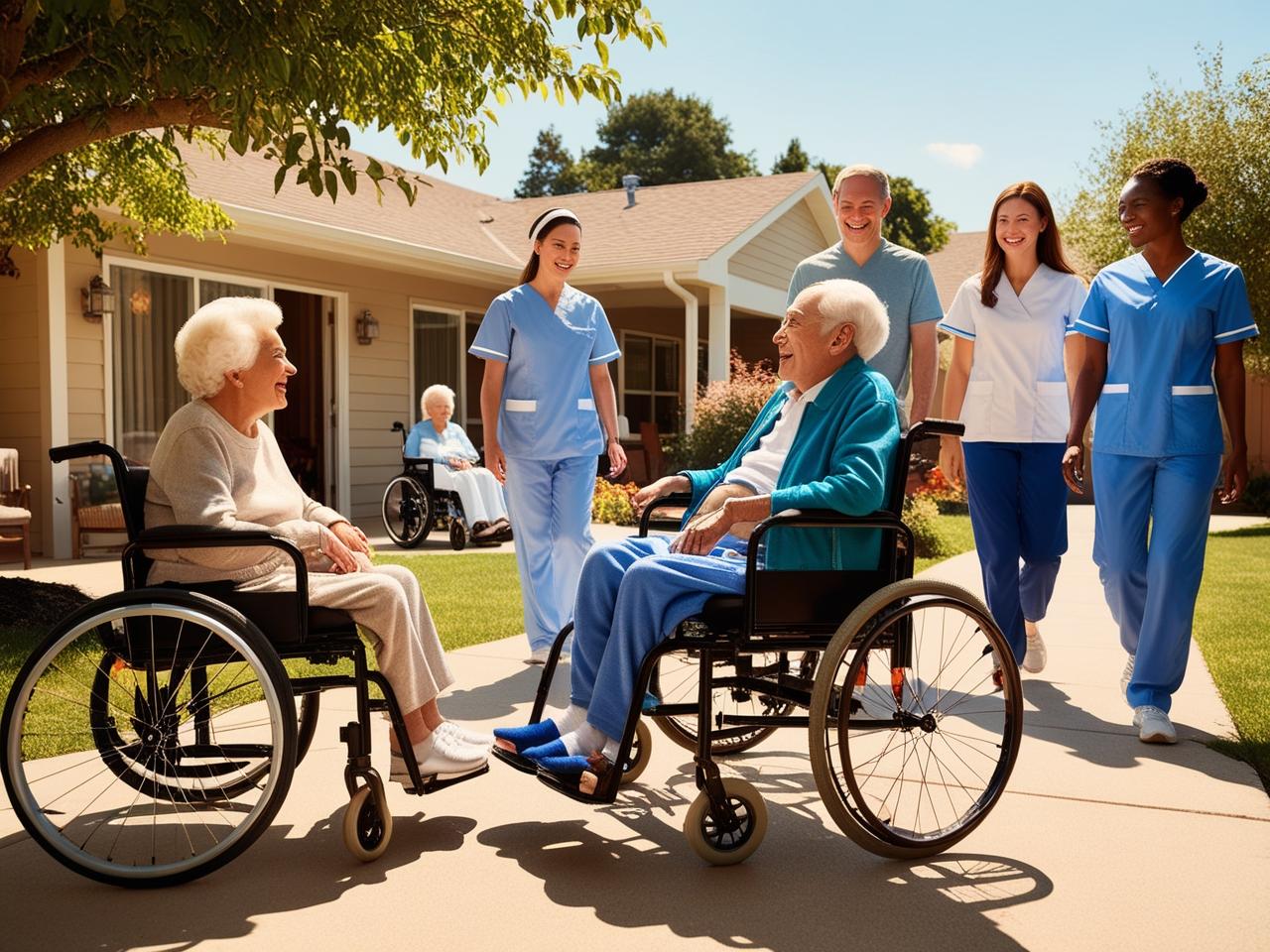In today’s world, many families find themselves faced with the challenge of determining the best senior care options for their loved ones following a period of short-term rehabilitation. This crucial decision requires careful consideration and understanding of the different care options available to ensure the highest quality of life for seniors in need.
- Short-term rehabilitation is a critical phase in the recovery process for many seniors, providing specialized care and therapies following a hospital stay or medical procedure. It serves as a crucial bridge between acute care and long-term senior care options.
- Transitioning from short-term rehabilitation to senior care can be a complex and emotional process for families. Understanding the available care options is essential to ensuring the well-being and comfort of elderly loved ones during this transition period.
Brief Overview of Short-Term Rehabilitation and Transition to Senior Care
Short-term rehabilitation facilities offer specialized, short-term care for seniors recovering from illness, injury, or surgery. These facilities focus on providing rehabilitation services such as physical therapy, occupational therapy, and nursing care to help patients regain strength and independence.
As seniors complete their short-term rehabilitation programs, families must carefully evaluate the next steps in their care journey. Senior care options may include assisted living facilities, memory care communities, nursing homes, or home care services, depending on the individual needs and preferences of the senior in question.
Importance of Understanding Senior Care Options for Families
Choosing the right senior care option is a decision that can significantly impact the quality of life and well-being of elderly loved ones. By gaining a comprehensive understanding of the different senior care options available, families can make informed decisions that align with the unique needs and preferences of their seniors.
It is essential to consider factors such as level of care needed, location, amenities, cost, and community atmosphere when exploring senior care options after short-term rehabilitation. By taking the time to research and assess these factors, families can ensure that their seniors receive the highest quality of care and support tailored to their individual needs.
Understanding Short-Term Rehabilitation
Short-term rehabilitation is a pivotal aspect of healthcare services for seniors, offering comprehensive care in a focused time frame to help individuals regain independence and quality of life after an illness, injury, or surgery. In this chapter, we will delve into the definition, purpose, benefits, typical length of stay, and services offered in short-term rehabilitation facilities.
Definition and Purpose
- Short-term rehabilitation refers to a specialized form of care provided to seniors for a limited period, usually ranging from a few days to a few weeks.
- The primary purpose of short-term rehabilitation is to help individuals recover physical, cognitive, and functional abilities through a structured and intensive program tailored to their specific needs.
- Patients in short-term rehabilitation may include those recovering from joint replacement surgeries, fractures, strokes, cardiac events, or other acute conditions.
Benefits of Short-Term Rehab for Seniors
- One of the key benefits of short-term rehabilitation is the focus on personalized care and treatment plans aimed at maximizing recovery and improving overall well-being.
- Seniors in short-term rehab often experience faster and more effective recovery compared to those receiving care in other settings.
- Rehabilitation services can help seniors regain mobility, strength, balance, and independence, reducing the risk of functional decline and enhancing their quality of life.
Typical Length of Stay and Services Offered
- The typical length of stay in a short-term rehabilitation facility varies based on individual needs and treatment goals but commonly ranges from one to three weeks.
- Services offered in short-term rehab may include physical therapy, occupational therapy, speech therapy, nursing care, medication management, wound care, psychological support, and nutritional guidance.
- The interdisciplinary team in a short-term rehabilitation facility collaborates closely to assess progress, adjust treatment plans, and ensure a seamless transition back home or to a long-term care setting.
Navigating the Transition to Senior Care
As our loved ones gracefully age, the transition to senior care becomes a critical topic of consideration for many families. Understanding the signs that indicate a need for ongoing senior care, exploring available options, and effectively communicating with seniors and family members are vital aspects of navigating this phase with care and compassion.
Signs that a loved one may require ongoing senior care
- Changes in mobility and independence
- Forgetfulness or confusion
- Difficulty managing daily tasks such as cooking, cleaning, or personal hygiene
- Unexplained weight loss or changes in appetite
- Increased frequency of falls or accidents
Factors to consider when exploring senior care options
1. Level of care needed
- Determine the specific assistance required, such as personal care, medication management, or specialized medical attention.
2. Location and proximity to family
- Opt for senior care facilities close to family members to facilitate visits and emotional support.
3. Budget and financial considerations
- Evaluate the cost of senior care options and explore financial assistance programs or insurance coverage.
4. Amenities and services offered
- Look for facilities that provide tailored services, engaging activities, nutritious meals, and a safe, comfortable environment.
Communicating effectively with the senior and other family members
- Approach the conversation with empathy and respect, considering their feelings and preferences.
- Keep lines of communication open and encourage honest discussions about senior care needs and preferences.
- Involve other family members in the decision-making process to gather diverse perspectives and support.
Navigating the transition to senior care requires thoughtful consideration, planning, and communication. By recognizing the signs that signal the need for senior care, weighing factors such as care level, location, budget, and amenities, and fostering open communication with the senior and family members, you can navigate this crucial phase with care and compassion.
Senior Care Options
As our loved ones age, making decisions about their care can be challenging. We will now explore the various senior care options available, including in-home care, assisted living facilities, and nursing homes. Each of these options has its own set of services, advantages, and disadvantages, making it crucial to understand them to make informed choices for our elderly family members.
In-home Care
In-home care services provide personalized care and assistance within the comfort of the individual’s own home. This option allows seniors to age in place while receiving the support they need to maintain their independence.
1. Definition and services provided:
- In-home caregivers offer a range of services, including assistance with activities of daily living (ADLs) such as bathing, dressing, and meal preparation.
- They may also provide companionship, medication reminders, light housekeeping, and transportation to appointments or social outings.
2. Pros and cons:
- Pros: Allows seniors to remain in familiar surroundings, promotes independence, personalized care tailored to individual needs.
- Cons: Cost may be higher than other options, limited availability of skilled medical care compared to nursing homes.
Assisted Living Facilities
Assisted living facilities are residential communities designed to provide housing, assistance, and support for seniors who require help with daily activities but do not need round-the-clock skilled nursing care.
1. Definition and services provided:
- Assisted living facilities offer a combination of housing, personal care services, and healthcare as needed.
- Services may include meal preparation, housekeeping, medication management, and recreational activities.
2. Pros and cons:
- Pros: Socialization opportunities, safety and security features, assistance with daily tasks.
- Cons: Limited medical care compared to nursing homes, may be costly for some families.
Nursing Homes
Nursing homes, also known as skilled nursing facilities, are residential facilities that provide 24-hour skilled nursing care for individuals who require ongoing medical attention and support.
1. Definition and services provided:
- Nursing homes offer round-the-clock nursing care, medication management, therapy services, and assistance with daily living activities.
- They cater to individuals with complex medical needs or those recovering from an injury or surgery.
2. Pros and cons:
- Pros: Access to skilled medical care, specialized services for chronic conditions, structured daily routine.
- Cons: Less independence compared to other options, potentially higher costs, limited privacy.
When deciding on senior care options, it’s essential to consider the individual needs and preferences of our aging loved ones. By understanding the services, advantages, and disadvantages of in-home care, assisted living facilities, and nursing homes, we can make informed choices that promote their health, well-being, and quality of life.
Making Informed Decisions
As families embark on the journey of choosing the right senior care option following short-term rehabilitation, engaging with healthcare professionals and social workers can provide valuable insights and guidance. These experts form a vital support system in understanding the myriad of choices available to ensure the well-being and comfort of our elderly loved ones.
Consulting with Healthcare Professionals, Social Workers and Senior Transition Specialists
- Healthcare professionals possess a wealth of knowledge in geriatric care and rehabilitation practices. Don’t hesitate to consult with them to understand the specific needs and preferences of your loved one.
- Social workers can offer invaluable assistance in navigating the complex landscape of senior care options. Their expertise in coordinating resources and facilitating communication can be instrumental in finding the most suitable solution.
- Senior Transition Specialists are trained in assessing the needs of the senior patient. They are quite knowledgeable about communities that would accommodate the needs of the patient and their families.
Touring and Evaluating Senior Care Facilities
- The physical environment of a senior care facility plays a significant role in the well-being of its residents. Take the time to visit and evaluate different facilities to ensure they meet the standards of comfort, safety, and convenience.
- Interacting with staff and observing the quality of care provided can give you a sense of the level of attention and support your loved one will receive in that environment.
Reviewing and Understanding Legal Documents and Contracts
- Before finalizing any senior care arrangement, it is essential to carefully review all legal documents and contracts involved. Seek clarification on any terms or conditions that may be unclear to avoid misunderstandings in the future.
- Understanding the rights and responsibilities outlined in these documents will empower you to make informed decisions that safeguard the interests of your family member and ensure a smooth transition into the chosen senior care setting.
By following these steps and seeking guidance from healthcare professionals, social workers, and legal advisors, you can navigate the intricate process of selecting the most suitable senior care option for your loved one post-rehabilitation. Stay informed and proactive to provide the best possible care and support during this important decision-making journey.
Emotional Support and Decision-Making in Senior Care Transition
When a loved one undergoes short-term rehabilitation, the transition to senior care options can be an emotionally challenging process for families. Navigating through complex decisions and responsibilities can lead to feelings of guilt, stress, and uncertainty.
Emotional Support for Families
- Coping with guilt and stress: It is natural for family members to experience guilt and stress during the senior care decision-making process. Recognize that these emotions are common and valid, and try to focus on providing the best possible care for your loved one.
- Seeking help from support groups or counseling services: Don’t hesitate to seek support from others who are going through similar experiences. Support groups and counseling services can offer a safe space to share your feelings, receive guidance, and find comfort in knowing that you are not alone.
In conclusion, emotional support is crucial during the transition to senior care options after short-term rehabilitation. By coping with guilt and stress, seeking external help, touring facilities, and reviewing legal documents, families can make well-informed decisions that prioritize their loved one’s well-being. Stay informed, stay connected, and most importantly, stay compassionate throughout this journey.
Conclusion
We hope that this guide has equipped you with valuable information and resources to navigate the complex landscape of senior care options. Your dedication and efforts in exploring senior care for your loved ones will undoubtedly make a meaningful difference in their lives.
For further assistance or information, feel free to reach out to us or consult with senior care professionals to address any specific concerns or questions you may have. Wishing you and your loved ones all the best in this important journey.
Please Note:
When considering a senior care facility for your loved ones, it’s crucial to understand the various rules and requirements that govern these establishments. Senior care facility rules and requirements differ based on the company’s policies and state regulations, making it essential to be well-informed before making a decision.




Leave a Reply